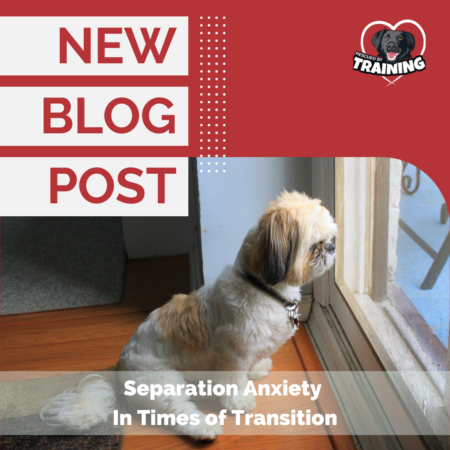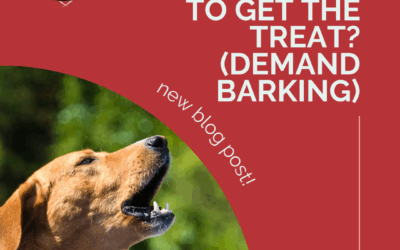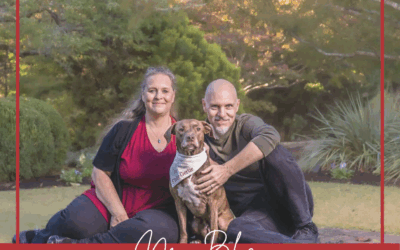I’ve written in the past about behavior regressions in areas like separation anxiety or house training. But occasionally new separation-related behavior issues pop up in dogs who have not previously displayed any separation issues. Sometimes this can be medical related, like undiagnosed pain, so if nothing else in the dog’s world has changed except their behavior, I’d recommend a vet check. But sometimes these changes can be very transitory, like the dog is staying in a new temporary location or with new people – a hotel, AirBnb or dog sitter’s home. Other times, the situation maybe be a little more long-term, like if there’s been more permanent changes happening in the family – a move, death of a human or animal housemate, divorce, addition of new partner or child, construction/renovation at home or nearby (especially in apartments where noises can be heard), or significant schedule/work changes which result in changes in the dog’s daily routine.
What’s the best way to approach this and help your dog if they’re struggling?
Prepare ahead of time:
- If you’re moving, try to acclimate your dog to the new location to ease the transition and make the move less startling. I have this post on Moving With Your Dog.
- If you’re having a baby or your baby is becoming a toddler, don’t just assume or hope your dog will be fine. Help set them up for success by doing some specific training far in advance before your dog is struggling. I have my pre-baby prep self-paced course or one-on-one pre-baby/toddler sessions available. Note: If your dog is showing fearful behavior (growling, lunging, barking, biting, snapping, etc.) at your baby/toddler, please schedule a fear and aggression consult.
- If your dog will be staying with a pet sitter for an extended period of time and the sitter plans on leaving your dog alone, consider doing a trial stay of 1-3 days before your long vacation where you are still around/home but your dog stays with the sitter to see how well they adjust and to give the sitter a chance to do some “soft” trial, monitored departures. (More on that below!) If your dog has never stayed alone anywhere but your own home, it would also be a good idea to have you do some trial runs ahead of your dog sitter stay. Maybe try some departures and alone time at a friend or family member’s home that is a little familiar and then a less familiar location. Your dog sitter will appreciate having some information on how your dog has tolerated absences in other locations before your dog comes to stay with them.
- Consider talking to your vet about whether some anti-anxiety medication may be an option during these times of transition. Even if your dog isn’t generally anxious, times of transition can be upsetting to dogs, and anti-anxiety medication can help take the edge off and help them be a little more comfortable and settle into these new situations or environments without being so stressed. This is good for their well-being, and yours.
- If you are planning construction/renovations or your building or neighbors are, if possible make plans to remove your dog during this process. Consider sending them to daycare or to a friend’s house or to boarding if needed. These noises can be very upsetting to dogs (their hearing is more sensitive than ours!) and we know there’s also a link between noise sensitivity and pain so loud noises from construction could be very upsetting or even painful if your dog has existing joint pain.
During the transition/change:
- Try to maintain as close to a normal routine as possible. Predictability and routine can help reduce anxiety. If your personal schedule has changed, try to hire a walker or someone else to help maintain the dog’s routine as closely as possible.
- Ensure exercise/enrichment needs are being met. Especially when our lives are turned upside down, whether it’s good or bad – a baby comes home or there’s a death or divorce – often the emotional load we’re under means the dog inadvertently becomes less of a priority. We may not feel up to walking them as much or maybe dog park outings aren’t as frequent or as long. Try to prioritize your dog’s exercise and enrichment needs as a way to prevent frustration and behavior issues from arising. Increase daycare if possible. Hire a dog walker. Outsource and ask for help. Show visitors, who want to help when you’ve had a baby, how to stuff a Kong, so you can have a stash in of frozen toys in your freezer for your dog when you need them.
- Use noise masking like box fans, loud TV/radio, noise machines in new or noisy environments (like hotels, apartments, construction areas) to try to help block some of the sounds for your dog.
- Do “soft intros” to alone time in new environments. Don’t expect that just because your dog could be comfortable in your previous, familiar location for hours, that in a new place, the same will apply. Take several days, or longer, to introduce safe, controlled short absences where the dog is being monitored via video while you’re away and you return before there is any sign of vocalizing or showing any signs of stress. What do I mean by “short absences?” To start 1-2 minutes. If your dog settles comfortably with that, then you can increase to 4-5 minutes the next time and gradually and incrementally build from there. But a “short” departure is not an hour. And you must be watching the video the entire time. It is also important that your dog cannot see or hear you at all. So if you’re standing in your apartment hallway, turn your phone on mute, don’t talk to neighbors when they say hi to you and don’t make any noise. If you’re standing outside your house, make sure your dog cannot see or hear you from any of the windows or doors. If your dogs starts to show any signs of discomfort, immediately return. It’s incredibly important we don’t just let dogs “cry it out,” as this can have grave consequences for their emotional wellbeing and for your relationship with your dog.
- Comfort your dog. Spoil your dog. Give them extra attention, love, play, fun training, and do more activities your dog enjoys. Do more of what your dog loves! Tough love isn’t the way to go here. Your dog is struggling with a transition and you helping comfort them will help them ease into this transition. Doing more of the things your dog loves will help increase happy endorphins and combat any cortisol spikes that may be happening from triggers or stressful things.
- Be understanding that your dog also may be more reactive or on edge due to trigger stacking or elevated cortisol levels and may be reacting to things they wouldn’t normally react to. Be kind, patient and remember your dog doesn’t understand the changes that are happening like you do.
- Never use any aversives, including yelling, hitting or using a shock collar to “correct” behaviors, including barking. Barking can be frustrating and annoying but it’s your dog communicating. Figure out what your dog is trying to tell you.
- Get a vet check if your dog’s behavior doesn’t resolve or is getting worse, especially if there’s any self-injury behaviors like over-grooming, pulling out fur or excessive licking. Often behavior is the canary in the coal mine, so to speak, for undiagnosed physical issues or pain.
Major life changes often trigger behavior changes so knowing to expect it and to prepare for it, can help set everyone up for success.
If your dog is struggling when left alone on a regular basis, reach out today and schedule your assessment. There is hope. I also offer my self-paced Separation Anxiety Foundations Course. Separation anxiety training isn’t a quick fix but with proper training, this disorder can be resolved or greatly improved. I can help you and your dog’s quality of life, strengthening your relationship and bringing relief to both of you. Don’t you both deserve that?
Happy training!
![]()




